I’ve decided to switch over to blogspot, so please click the super-cool new Summer of ’74 logo to visit the new home of my card blog. The wordpress site will remain up, but is now inactive. Thanks the memories.
Month: April 2017
The All-time Brewers Project
I got back into collecting cards about 10 years ago, trying to build a sort-of master set of Topps flagship Brewers. I ended up expanding that quest to try to build a COMPLETE set of Brewers cards – as in one of everything ever – but I got lost in the 2000s, when a zillion different companies were making a zillion different sets that I really couldn’t care less about. Now that I am trying to refocus my collecting goals create some collecting goals, I’ve gotten away from the completist tendencies that had previously taken a lot of fun of the hobby. I want to rebuild my Topps flagship sets (decimated by my TTM habit) and built some Topps complete sets.
But I’ve still got that ‘collect ’em all’ bug. So, in a compromise with myself, I’ve decided to embark on what I’m calling the “All-Time Brewers Project,” in short, one card of every players who has ever appeared in a game as a Brewer.
I already had a good head start on this project, thanks to a 1994 Miller Beer promotion in which they issued stadium give-away sets of every Brewers player from 1970-1993. And, with a couple of late nights with a few cans of the sponsor’s ice-cold product and a stream of Simpsons eps on the TV, I manged to cobble together a set of about 640 of the roughly 820 players on the Crew’s all-time roster (these are rough estimates).
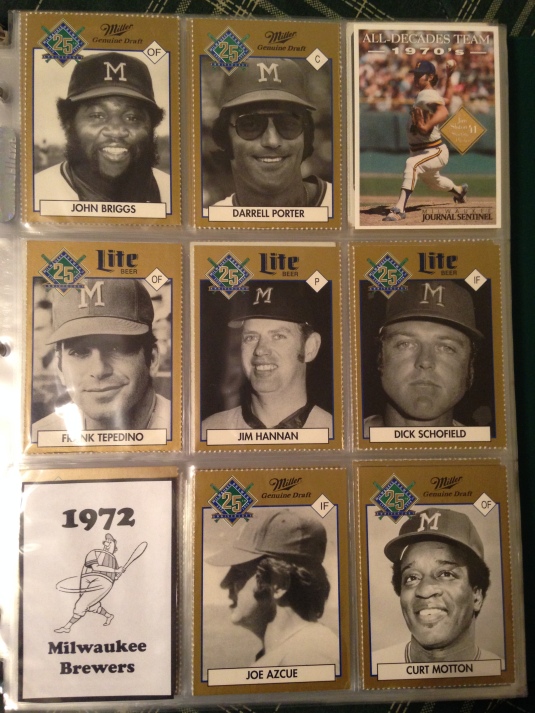
I also made some cute little year dividers. I’ve arranged them by the year of their debut, according to the all-time roster I found on brewers.com. As you can see, the Miller cards are, to put it mildly, a bit hard on the eyes. I’m in the process of swapping them out with more standard-issues when I come across them. But they are excellent for providing cardboard of obscure or short-term Brewers, like Dick Schofield, who spent about ten minutes of his 18-year career in Milwaukee and appears on no other card as a Brewer.
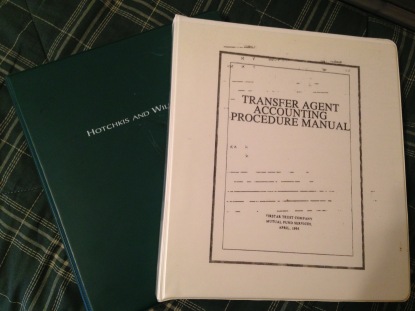
I’d also like to upgrade the binders I’ve got these beauties in. I stole was given these from an office job that was eventually laid off from.
Aside from the collector’s pride I feel in putting this thing together, it has already proven to be a pretty valuable research tool in getting me to more closely examine in the all-time roster. For example, I’ve learned that in their entire history, the Brewers have only had ONE African-American start a game at catcher. That would be Marcus Jensen, who had two tours with the team, in 1998 and 2002. Sadly, he does not have a Brewers card.
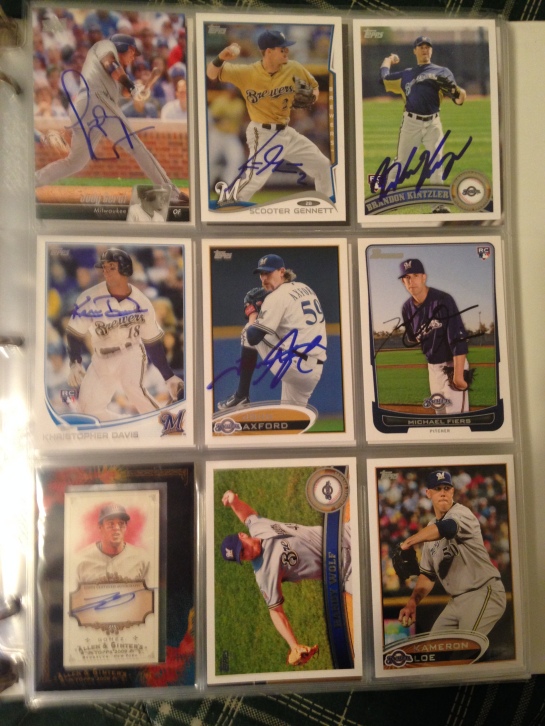
I’ve also transfer my Brewers autograph collection in the all-time binders. Of the 600-some different player I’ve got, maybe 100 are signed. I’d like to work on increasing that number as well.
I have a list of the Brewers I still need on my want lists page. A big chunk of the remainders never had a Brewers card issued, and another big chunk only have team-issue cards with them in Brewers dress. Oddly enough, Pacific – the one card company that I truly loathed as a kid – is a pretty good source of Brewers cards that no one else bothered with in the 1990s and 2000s, including the only card of Julio Franco in a Brewers uniform.
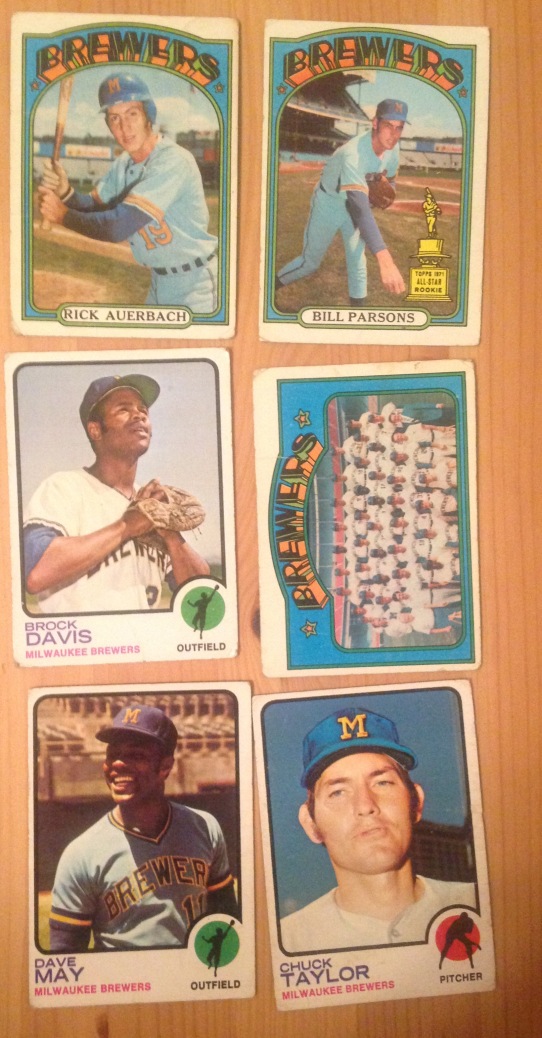
Mark Hoyle, who does not have a blog (at least I don’t think he does), but is on twitter as @markhoyle4, sent me a PWE of vintage Brewers that can in handy for upgrading the Miller cards. Thanks Mark!
There is a card show in the Milwaukee area on the 23rd, where I can hopefully find some more updates and autos and maybe knock a few names off my need list. But, as always, I’m accepting any unsolicited help.
A Warren Spahn Story and a Trade Offer
It was 14 years ago this month that Warren Spahn, one of the greatest lefties the game has ever known, passed away. Mr. Spahn was a pretty good TTM signer in his later years, and I had the good fortune to get him to sign a couple of items for me. One was a 1962 Topps All Star card, the other was a bit more… unexpected. Before I explain, let’s go to the photos!
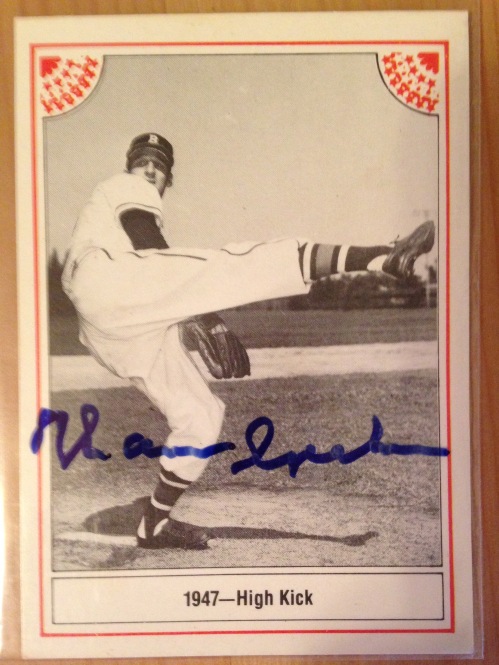
Here is Spahn signature on one of those old SSPC cards.
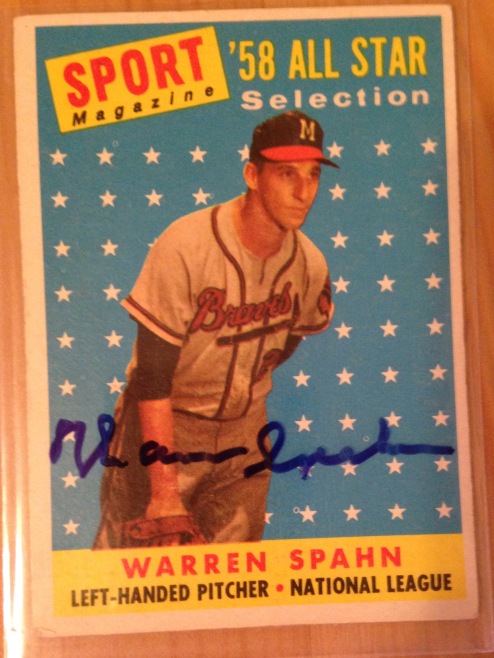
And here is a very nice-looking sig on a 1958 All Star Card.
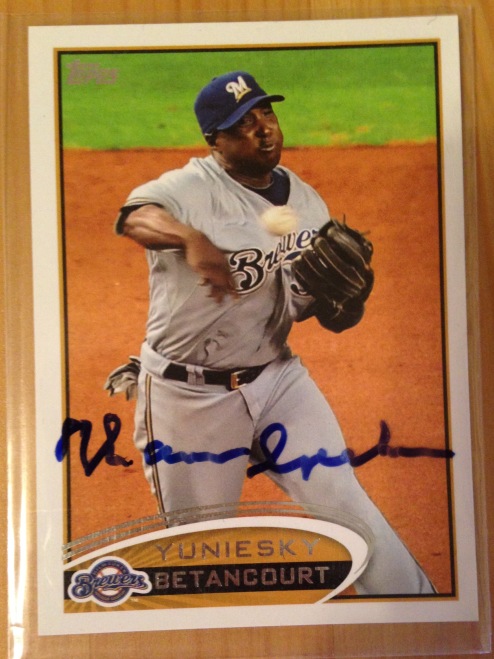
Oh, and here is a rare item – a Warren Spahn autograph on a Yuni “Don’t tell Doug Melvin that I actually Suck” Betancourt card that was printed nine years after he died. a 1/1 indeed!
What sorcery is this?!?!
None, of course. When I sent Spahnnie the card, back in about 2001, I think, I had it in a old penny sleeve. He mistakenly signed the sleeve before he signed the card. So, I ended up with two sigs for the price of one (five dollars, if I recall). This is a pretty cool item in the sense that it turns any Spahn card, or any card really, into a signed card. Sort of like a much-less intrusive sticker.
Now, as someone who keeps my signed cards in a binder, this item is of little use to me. So if anyone wants to make me an offer for it – I’d much prefer to trade it – I’m all ears. I’ll admit that the sleeve isn’t exactly in top shape. There are no overly noticeable blemishes, but it’s not pristine, either. I’ll also note that it is large enough for 52-56 sized Topps cards. What do I want for it? I dunno. I have my want lists up and up-to-date. I’m always interested in any Brewers auto that I don’t have. Or just promise to send me something equally as cool and worthwhile. Like this penny-sleeve, I’m flexible.
An Opening Day Story
In honor of Opening Day, I’d like to share a story I wrote for a local online newspaper some time ago, Involving one of my very favorite items from my collection:

I have to say, I nearly plotzed when I found this ticket on eBay. Full tickets for the old American Association Milwaukee Brewers are a tough find, particularly special event tickets for an opening day or playoff game (for an excellent blog on the Brewers and Borchert Field, check this out). But this ticket was the rarest type of all, one with a weird backstory and vivid historical significance. Milwaukee County Stadium (1953-2000) was a trendsetter among major league sports stadiums, publicly financed and located outside of the urban city center. The city of Milwaukee had been toying with the idea of a municipal stadium since the 1930s, following the basic idea put forth by Cleveland Municipal Stadium, a multipurpose facility funded by public bonds. Several sites were proposed, most either on the western edges of the city or on the lakefront. As early as 1935, the minor league Brewers were interested in using a city-financed ballpark to replace Borchert Field, an oddly shaped wooden park at Eighth and Chambers.

Borchert Field, home of the Brewers, 1902-1952
The idea lingered but got no real traction until the 1940s, when a site at Story Quarry was approved by city and county officials. By then, however, wartime shortages in building material put construction plans on hold. It was also around this time that the possibility of a Major League Baseball franchise moving to Milwaukee was raised. Milwaukee had been a charter member of the American League back in 1901 but had lost its poorly supported team to St. Louis. Now, the AL was trying to shift that same fledgling team, known as the St. Louis Browns, to a more promising location. Having been a hardy supporter of the minor league Brewers for decades, and showing real interest in building a new Major League-ready facility, Milwaukee was considered a prime destination.
Ground was finally broken on the new stadium in October 1950, and for the next two years, rumors flew over which big league team would get to call it home. Through 1950 and ’51, it seemed that the Browns would land in Milwaukee. Miller Brewing president Fred Miller was set to buy the team and move them north, reports said, with a complicated swap of the Browns’ home park in St. Louis to the NL Cardinals, who would then fold their minor league club in Columbus, allowing the Brewers to move to Ohio.
Other reports claimed that, as the parent club of the Brewers, only the long-suffering Boston Braves could move to Milwaukee. Fred Miller was supposedly in on this deal as well but also was eying other teams. It was reported that the Philadelphia A’s, St. Louis Cardinals (!), and Chicago Cubs (!!) were all candidates for relocation.

Meanwhile, the opening of the stadium was pushed back due to construction delays. On Jan. 31, 1952, with Milwaukee backers still courting various teams, an opening date of July 24 was announced for the opening of the new park, with the Brewers taking on an American Association opponent. By the opening of the 1952 season, that opening date had been pushed back yet again, but the Brewers still planned on being the new stadium’s primary residents. A grammatically-muddled tagline of Watch for Brewer Opening in Milwaukee County’s New Stadium! appeared on that year’s pocket schedules. A program from late in the season featured an artist’s rendition of County Stadium, The Future Home of the Milwaukee Brewers.
 Borchert Field and County Stadium
Borchert Field and County Stadium
In January 1953, a firm opening date of April 15 was set for the new stadium’s debut, with the Brewers set to take on the St. Paul Saints. Fighting off rumors that it was only a matter of time before a Big League tenant would be found for the park, forcing the Brewers to relocate, General Manager Red Smith told the press, “The Brewers will definitely operate in Milwaukee in 1953.” The team moved its offices into the new stadium, with correspondence going out on letterhead with a watermark of County Stadium. That spring, the team began to sell game tickets, including about 12,000 to the highly-anticipated opener.
That is to say, the opening of the Stadium was anticipated. The actual playing of the Milwaukee-St. Paul game scheduled for April 15 was a terrifying proposal to local baseball boosters. As teams prepared to head south for spring training, there was still doubt as to whether or not Milwaukee’s big league ballpark would have big league tenants. The Browns, now owned by former Brewers owner Bill Veeck, were ready to make the switch, but Boston Braves owner Lou Perini would not give up his Milwaukee territory, not unless the Brewers could shift to a market comparable to Milwaukee. Frustrated by the prospect of the Brewers opening in the new stadium, Clifford Randall of the Greater Milwaukee Committee told the press, “You can bet we didn’t spend five million dollars for a new stadium for minor league baseball.”

Of course, it was Perini’s own Braves that finally made the shift to Milwaukee . On March 19, the move was approved by the National League and Milwaukee rejoiced. The phone lines at the Brewers’ County Stadium office were instantly alight with people wishing to buy Braves tickets. The skeleton staff at the Stadium wasn’t sure what to do, or even, at that moment, who they worked for. Down in Florida , the new Milwaukee Braves, with Bs still on their caps, took on the Yankees. Elsewhere in the state, a team took to the field wearing Milwaukee Brewers caps and jerseys, although no one was really sure what to call them.
After assembling an office in Milwaukee, the Braves announced that tickets would go on sale on April 1, with an opening date set for April 14 against the Cardinals. Before any Braves tickets would be sold, a team official said, Brewers opening day ticketholders would have the chance to exchange them for the April 14 opener. The official also begged Milwaukeeans to stop calling the old Brewers offices looking for tickets. Meanwhile, the Brewers began the process of shifting their operation to Toledo, where they would become the Mud Hens.
There was no word of what was to happen to the Brewers tickets that were swapped in for Braves seats. Presumably, they would have been destroyed, with a few maybe kept as souvenirs. It seems highly unlikely that anyone would have kept their ticket instead of trading it in, although some people might have been miffed at having to pay the difference in price (this $1.75 ticket would have needed an extra seventy-five cents to get the Braves seat). In the event this was a ticket that someone held on to, they would have missed a great game. Warren Spahn threw ten innings and was one of five future Hall of Famers to play in the game. Billy Bruton won it for the Braves in the bottom of the tenth with a walk-off homer that glanced off the mitt of Enos Slaughter and over the barely-completed outfield fence. The Braves would play for 13 years in Milwaukee, winning two pennants and a World Series.
